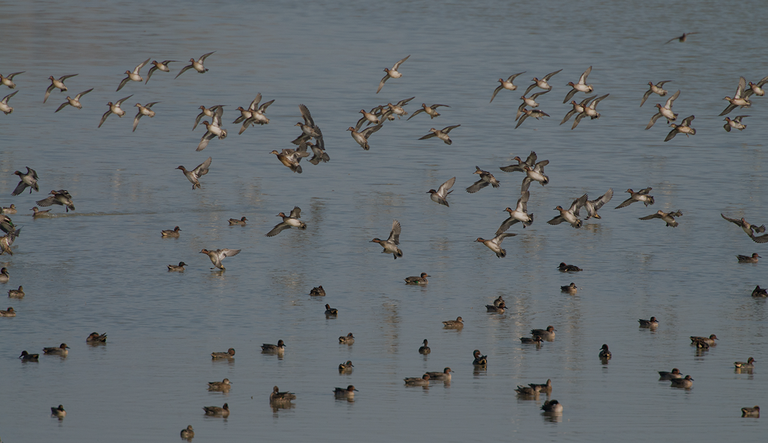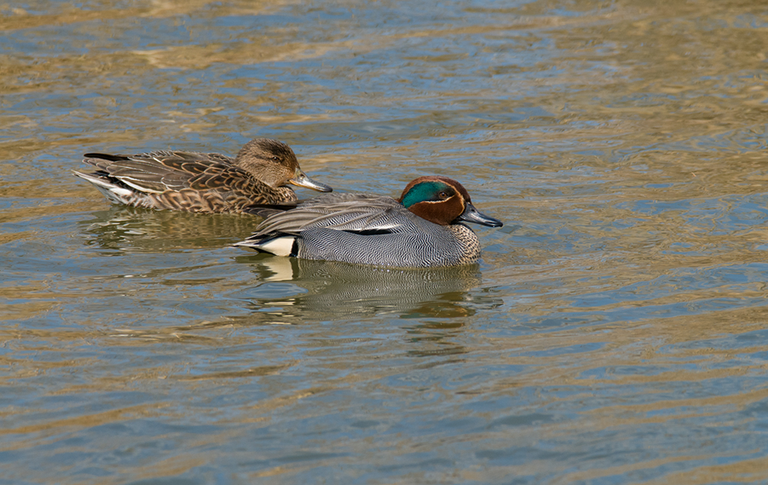Avian botulism and wild birds: first report in Italy of a severe outbreak in a protected area
Between late summer and early fall 2019 and during the following three years, the outbreak occurred in a wetland of Northern Italy, in Regional Park ”Delta del Po Emilia-Romagna”. A study, published in “Animals” MDPI journal and written by ISPRA researchers, analyzes the sequence of events in relation to environmental conditions and mitigation management measures.
Botulism is a neurological disease affecting humans and other animal species and is due to different types of neurotoxins produced by bacteria of the genus Clostridium, usually C. botulinum. Some of these neurotoxins (e.g. related to canned food) are responsible for human botulism while others can impact on wild birds around the world, causing mortality episodes from a few cases to severe epidemic trends, as happened during the 1932 die-off in the Great Salt Lake in North America that led to the death of about 250,000 waterbirds.
On 5 September 2019, several bird carcasses were recovered in the Valle Mandriole protected area (Ravenna province, Regional Park” Delta del Po Emilia-Romagna”, Northern Italy) and submitted to the Istituto Zooprofilattico Sperimentale della Lombardia e dell’Emilia Romagna (IZSLER) labs, where analyses performed showed the presence of neurotoxin-producing clostridia.
The first measures taken by the technical table established to manage the avian botulism emergency — table coordinated by the Ravenna Municipality, with the participation of delegates representatives of several territorial bodies and local stakeholders, including also the “Delta del Po Emilia-Romagna” Regional Park, the veterinary service of the AUSL of Romagna, and the Emilia Romagna Region — included the recovery of intoxicated birds still alive and the prompt removal of the carcasses of dead birds. This action is very important to reduce the outbreak propagation due to the development in bird carcasses of carrion fly larvae that represent both biological accumulators of neurotoxins present in dead animals and sources of further intoxications when are preyed by other birds that in turn became intoxicated, giving rise to a natural cycle enhancing the survival and spread of neurotoxin-producing clostridia.

Photo: A. De Faveri ISPRA A flock of teals (Anas crecca). These small ducks are among the most abundant wildfowl during the autumns and winter in freshwater wetlands of the souther Po Delta
Botulism is a neurological disease affecting humans and other animal species and is due to different types of neurotoxins produced by bacteria of the genus Clostridium, usually C. botulinum. Some of these neurotoxins (e.g. related to canned food) are responsible for human botulism while others can impact on wild birds around the world, causing mortality episodes from a few cases to severe epidemic trends, as happened during the 1932 die-off in the Great Salt Lake in North America that led to the death of about 250,000 waterbirds.
On 5 September 2019, several bird carcasses were recovered in the Valle Mandriole protected area (Ravenna province, Regional Park” Delta del Po Emilia-Romagna”, Northern Italy) and submitted to the Istituto Zooprofilattico Sperimentale della Lombardia e dell’Emilia Romagna (IZSLER) labs, where analyses performed showed the presence of neurotoxin-producing clostridia.
The first measures taken by the technical table established to manage the avian botulism emergency — table coordinated by the Ravenna Municipality, with the participation of delegates representatives of several territorial bodies and local stakeholders, including also the “Delta del Po Emilia-Romagna” Regional Park, the veterinary service of the AUSL of Romagna, and the Emilia Romagna Region — included the recovery of intoxicated birds still alive and the prompt removal of the carcasses of dead birds. This action is very important to reduce the outbreak propagation due to the development in bird carcasses of carrion fly larvae that represent both biological accumulators of neurotoxins present in dead animals and sources of further intoxications when are preyed by other birds that in turn became intoxicated, giving rise to a natural cycle enhancing the survival and spread of neurotoxin-producing clostridia.
Additional measures taken to counteract the life cycle of these bacteria relied on controlling water levels in the affected valley. In wetlands and notably in freshwater habitats, neurotoxin-producing clostridia develop when organic material — of plant or animal origin — decomposes in concomitance with high temperatures and oxygen deficiency in the water (anoxia), exactly the conditions that, associated to low levels of rainfall, occurred in in Valle Mandriole in the Summer of 2019. Two alternatives were available to deal with the avian botulism emergency: flooding or drying Valle Mandriole. Both actions can help to reduce the presence and the negative impact of clostridia by reducing, in the first case, the Clostridium spp. replication and driving away, in the second case, waterbirds that are the first victims of the disease. To prevent waterfowl from continuing their roosting in the few remaining pools, it was decided to proceed with desiccation. The strategy proved effective, and most of the 2158 birds killed by the disease died within the first few days of its onset and before the countermeasures put in place.
Avian botulism cases, occurred during the primary event between late summer and early fall 2019 and over the following three years, were reported and recently published in the MDPI journal “Animals”. In the article, written by ISPRA researchers with the collaboration of veterinarians and biologists from the Municipality of Ravenna, the AUSL of Romagna and the IZSLER, the series of events is analyzed in relation to the environmental conditions and the management measures of prevention, mitigation a monitoring derived from this experience, and to what happened in the three years following the recurrence of conditions favorable for avian botulism.
The survival of Clostridium spp. spores in a quiescent state in the soil and substrate of wetlands, and the winter persistence of toxins in overwintering pupae of carrion fly underscore the need to monitor botulism-prone areas, since under suitable conditions the disease can reemerge even after years from the first occurrence.
Valle Mandriole — a site of international importance under the Ramsar Convention and included among the regional protected areas and the ZSC/ZPS of the Natura 2000 Network — appears to be, like the other wetlands, among the most fragile of ecosystems and most exposed to anthropogenic climate change. Germination of Clostridium spp. spores, initiated by conditions of anoxia and decomposition of organic biomass in the presence of the high summer temperatures, can become a significant mortality driver for waterfowl that may ingest and thus spread botulinum neurotoxins.
The ecological approach to this environmental emergency has put into relation the life cycle of Clostridium botulinum, the management of water reservoirs under anoxia conditions, the climate change, and the health status of resident and migratory avifauna, thus making explicit the complexity of natural systems and the need for appropriate prevention and management of emerging diseases.

Photo: A. De Faveri ISPRA

